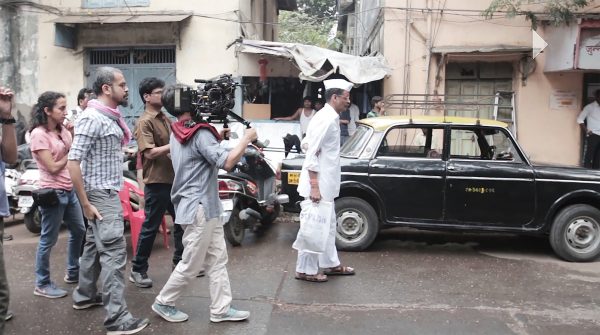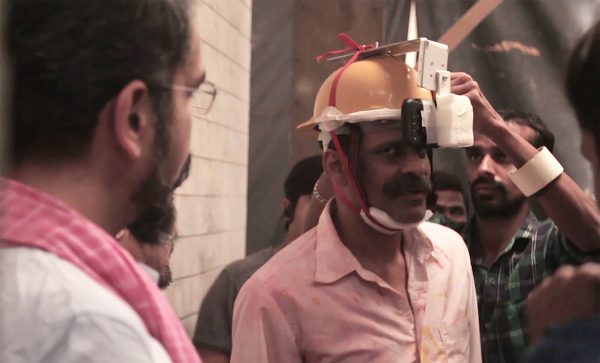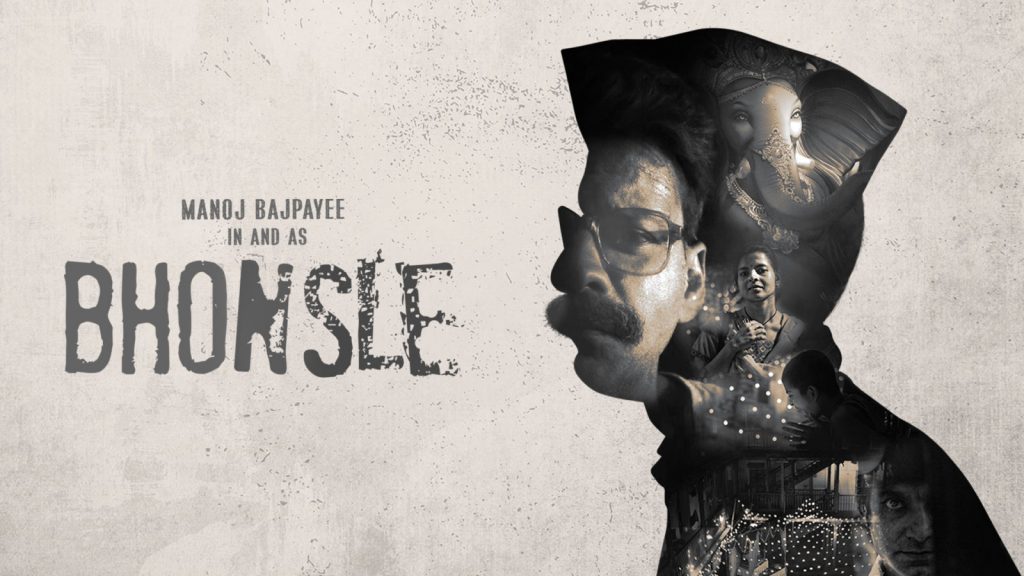Devashish Makhija’s Bhonsle (2018) starring Manoj Bajpayee in the title role is the riveting tale of a Mumbai policeman who has just retired from his job and prefers to live a solitary life in a sprawling working-class residential building, which is a world unto itself. The plot of the film takes a turn as he stands up against a divisive individual and as circumstances spiral out of control, he finally takes to dispensing justice in his own hands with the film culminating in an extremely violent finale. The film is currently streaming on SonyLIV since June 26, 2020. I caught up with Devashish to talk about the intricacies of this highly contemplative and thought-provoking film.
The film begins with two activities happening simultaneously on the screen – the idol of Lord Ganesha getting prepared for the festival, whilst the titular character has retired from his service and meticulously removing his police uniform. What was the purpose behind the juxtaposition?
Devashish Makhija: Such ideas work as a metaphor or an allegory. If I have to explain a ‘purpose’ behind it, it might flatten the experience of it. At the same time, if it feels somewhat vague, then perhaps I failed there as a filmmaker. That said, since you’ve asked, let me attempt to speak about some of the abstract ideas we meant to toy with here and not just the obvious symmetry between the two acts of Ganpati coming to life as our protagonist is leaving his. At the heart of crime noir is this philosophical idea of the ‘Death of God’, where ‘God’ represents a collective, societal morality. Bhonsle, among many other things, is at its very core a crime noir story. For starters, we manifest this noir idea of the Death of God in the religious-spiritual motif of how our Indian traditional society places our moral-ethical codes quite literally within the Gods we worship. Our film hopefully proceeds to explore the philosophical significance of one such God ritualistically ‘dying’ when it is immersed in the sea. Put simply, what this opening scene hopefully does, is create an expectation that in this film Ganpati will be a metaphor of sorts for Bhonsle, but then proceeds to subvert this expectation in little ways as the story progresses.
The protagonist of the film has developed a loathing towards his neighbors and prefers to have an isolated existence. But with the arrival of Sita and Lalu in the chawl, he slowly develops affection and stands as a protective figure to both of them. Does such a harmonious relationship happen due to the lack of a family in the lives of all these three characters?
Devashish Makhija: I’m not sure how to answer this. We often gravitate towards certain people because of a combination of many factors. The morally decaying, ethically fractured, emotionally turbulent society that Bhonsle is set in hopefully reflects our contemporary urban world as well. We have been conditioned from a very young age to be suspicious of strangers, making it difficult for two people to reach out to one another on an impulse. In such a world, for a Sita & Lalu and a Bhonsle to reach out to one another is nothing short of a happy miracle. People like them perhaps need to sense and identify common moral codes, similar belief systems, shared private histories, tragedies, and personal circumstances before they proceed to enter one another’s tightly drawn circles of existence. The fear of rejection is too high for them to attempt proximity on merely one of the above parameters.

How did you come up with the dream sequence with the aging Bhonsle? It was so elegantly shot and creatively executed.
Devashish Makhija: To justify a sequence such as this one, I had to orient the film to a despairing, decaying slowness around the first 40 minutes. The heart of the first 40 minutes is this ten-minute sequence of Bhonsle’s daily monotony segueing into a nightmare without warning. It is my favorite part of the film. And is probably one of my primary motivations to even want to make this film. This is the life my father led in Calcutta while I struggled to set up a life in Bombay for the both of us for over a decade. I did not succeed in making that life here, to bring him here to live with me as he passed away of Alzheimer’s last year. This sequence is hopefully a tribute to what he possibly had to endure in all those years of wishing for a more meaningful life. It’s too little too late. But the elegance you bestow on it is my father’s spirit manifest in those frames.
Vilas is an individual with political yearning. He flexes his muscle in the chawal and tries to portray himself as a dominant figure against the Bihari inhabitants. But whenever he confronts an opposing Marathi speaking individual he gets subdued. How would you like to define him?
Devashish Makhija: Vilas is a tragic irony. Although each one of his speeches is about the political idea of ‘belonging’, he himself doesn’t ‘belong’ or fit in anywhere. He spends his days and nights adrift, literally, living in a taxi – an anchorless floating little island of no fixed address. And he’s not comfortable with it. He tries to play the insider-outsider card each time he tries to recruit his fellow-Marathis to his political cause but ironically, he himself is an outsider to even his own kind. He’s incapable of earning acceptance, so demands it. And is repeatedly rebuffed. This is what makes him definedly desperate. It is this desperation that makes him subservient before his self-appointed father figures – be it Dange or Bhonsle. And it is this very desperation that makes them reject him.
Why did you cross edit the two waiting scenes – Bhonsle for Tawde and Vilas for Bhau? Is this because of a striking similarity between both of them?
Devashish Makhija: There must be for you to ask me this. But more than the obvious symmetry in their respective lives, the inter-cutting between them at that point in the story is hopefully to bring our attention to the dissimilarities between the two of them. And here, do allow me to quote from Christopher Nolan’s The Dark Knight – whereas Bhonsle appears to be an ‘immovable object’, Vilas appears to be an ‘unstoppable force’. Even as they both appear to be doing the same thing – waiting, they are doing so in dramatically different ways. One is anchored and unmoving in his private despair, seated most of the time. While the other is rudderless and constantly in motion, turning this way and that, desperately seeking something to anchor himself to. Symmetry is a helpful cinematic tool to exhibit the dissimilarity between entities. Quite like the opening sequence of this film also attempts to do.
As Bhonsle departs the police headquarter demoralized after meeting with Tawde, sounds of sea waves crashing on the shores are heard on the background. What kind of design did you have for the soundscape of the film?
Devashish Makhija: The rhythm of the sound of sea waves was given to Mangesh Dhakde to compose the music upon. In films made in the Hindi industry, often sound and music don’t function in tandem. It helped me on my earlier film, Ajji, as well as Bhonsle that the sound designer of both films, Kaamod Kharade, is a dear friend of the music director. They both studied Sound Recording and Sound Engineering at FTII, Pune, and share an ego-less camaraderie where one never feels that the other is trying to outdo their work. This empowered me to conceive the soundscape in the script itself sometimes knowing that discussions and explorations during preproduction and postproduction will help the three of us collectively discover the potency of these ideas. For example, the sea waves crashing gently on the shore ‘feels’ like the inner sound of Bhonsle’s despairing heart; an expansive, helpless, sorrowful inner sea that beckons Bhonsle into its folds now that his hopes have been belied. But when this sound returns in the end as Bhonsle lies dying, hopefully, we realise that this was always the sound of the final ‘immersion’ – of the god Ganpati, as well as Bhonsle – both metaphorically, as well as literally – into the sea. What I told Mangesh and Kaamod was that this sound (and the music) somewhere already must preempt the tragedy that the rest of this film is going to be. So this sound is the cue that points you to how and where this tale will end, thereby giving the proceedings a philosophical circularity like life itself. We attempted this with the sound and music design in the scene of Sita’s brutal violation – when the sound emotionally expands to also become an exploration of the violent madness of the Ganpati festival revelry as well as in the scene where Vilas drives manically, his psyche fracturing even as he speeds.

Why does Bhosle regret or apologize after every act of violence?
Devashish Makhija: It’s what we should all do perhaps when we sit judgment on someone else no matter how despicable the error of their ways. Everyone to some extent or the other is a victim of circumstance. We live in a morally complex world. Bhonsle tries to empathise with this complexity by acknowledging that there are no easy answers when we are asked to draw the line between right and wrong. In all the years in his police uniform, he probably saw many such lines blur. And now that he may never be in that uniform again, he may be apologising for all those quick judgments he made and the oversimplified punishments he handed out that may have caused his world to now be inhabited by one such as Vilas.
Is there anything symbolic in the scene where Bhonsle and Lalu are jointly stirring the paint in the can?
Devashish Makhija: I believe the most impactful symbolism lies in ‘subtext’. If it’s something that could not be caught by the viewer, then I’d rather not spell it out. This doesn’t necessarily diminish their superficial experience of the film. But if caught, they can enrich and deepen that same experience. That said, once again, I will contradict myself and attempt to discuss the somewhat obscure ideas at play in the scene you speak of. In this scene where Bhonsle and Lalu jointly stir the paint, there are (hopefully) multiple symbolisms at play. In a chawl where fathers and sons are falling apart, a man and a boy, who have no filial bond, are finding one through this innocuous act of mixing paint together. The colour yellow that they are stirring is the most politically neutral of colours in the world of Bhonsle. Red symbolizes the Left, and saffron the Right. When you remove red from saffron you end up with yellow – which is what Bhonsle decides they will ‘repair’ this wall with – thus taking away any scope of further politicization of his chawl. And hopefully leaving his apolitical legacy of fairness in his chosen son-figure – Lalu.
Finally, the honour of a female has been ravaged; hence a violent vengeance takes place at the climax of the film- this has been the arc of both, your earlier film, Ajji (2017), and Bhonsle. Is this a coincidence or intentional?
Devashish Makhija: Actually, neither. Bhonsle was written by Mirat Trivedi and me five years before we wrote Ajji. And these are the only two of over several dozen stories I’ve written (most of which haven’t seen the light of day yet) that have this as a motif. Perhaps producers and audiences find this motif ‘relatable’ in cinema? Left to my own devices, I may have prioritized the making of any of my several other scripts over Bhonsle once Ajji got made and released. But many factors go into the making of a film. The filmmaker’s prerogative is not the most paramount one sometimes, given how much money is at stake. And for a filmmaker like me, who has seen over fifteen films get shelved at different stages over fifteen years, its a miracle that a film even finds a chance to get made. So I allowed for this, knowing fully well that once released, I will be asked this question many times over. You just proved me right.


